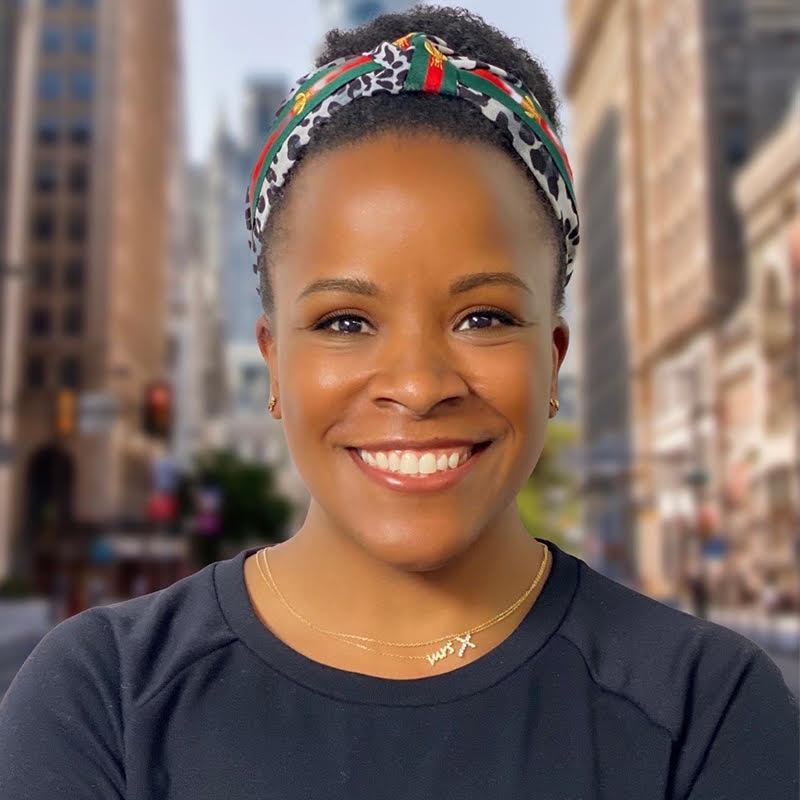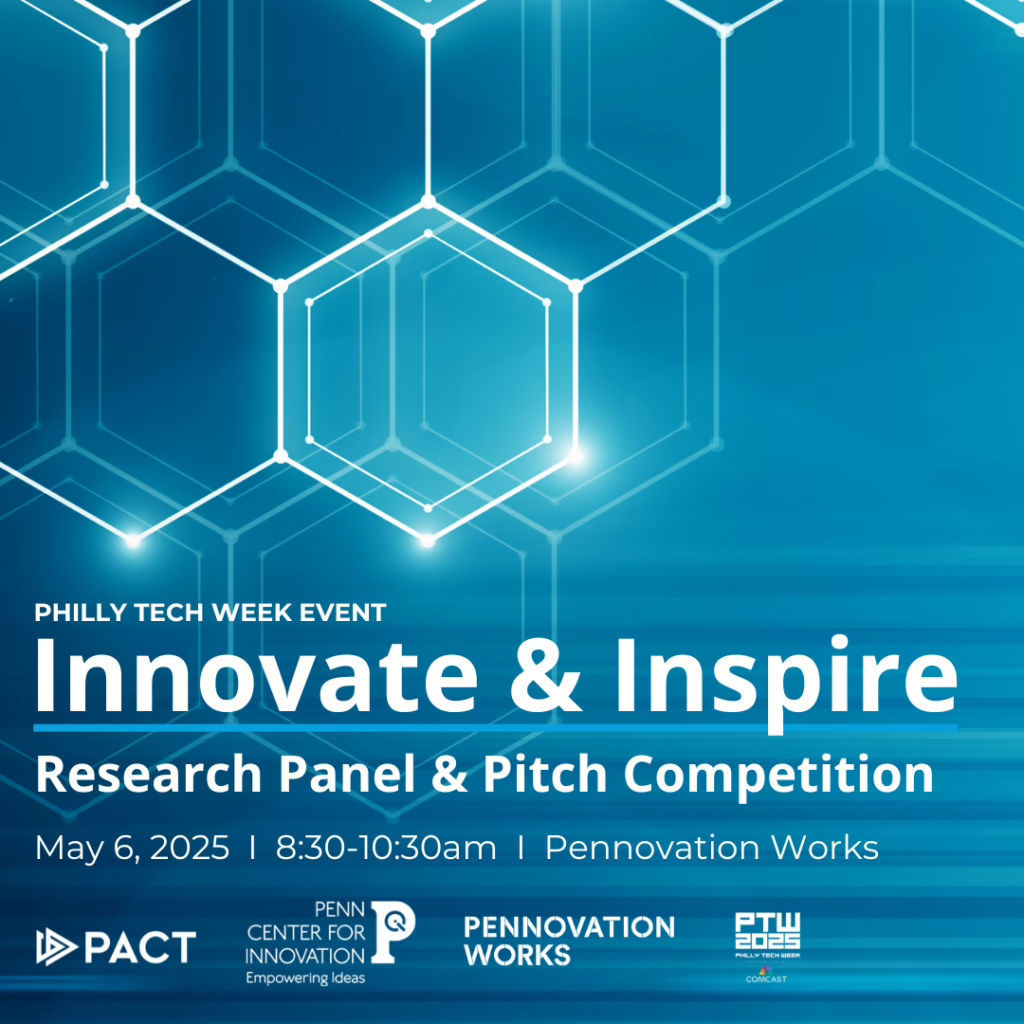Meet the PACT Staff – Heidi Franklin 26 Mar 12:48 PM (22 days ago)

What brought you to PACT, and what’s your favorite part of working here?
I had been captivated by PACT events while working in a previous role and admired the organization’s ability to bring people together around innovation and entrepreneurship. My favorite part of working here is showcasing Philadelphia’s vibrant innovation community and helping to elevate the incredible talent and ideas in the region.
How does your role at PACT help make an impact on the Philly tech and healthcare scene?
In my role, I strive to be a connector and collaborator for the innovation ecosystem. Through curated programming and strategic networking opportunities, I help bring together entrepreneurs, investors, and industry leaders to spark new ideas, partnerships, and growth across the tech and healthcare sectors.
Which PACT event do you look forward to the most, and why should members check it out?
The Enterprise Awards is my favorite event because it’s a true celebration of innovation and success in our region. It’s an evening of recognition, inspiration, and connection, where members can network with the who’s who of the innovation community in a fun and dynamic setting.
What’s a recent project or success at PACT that you’re really excited about?
The Mid-Atlantic Capital Conference is always a highlight! As a team, we work tirelessly to host a premier event for investors, entrepreneurs, and advisors. The energy and excitement throughout the conference are unmatched, and as soon as it ends, we’re already looking forward to planning the next one.
When you’re not working, what do you like to do for fun?
I’m a beginner fencer, an avid jogger (definitely not a runner!), and an aspiring foodie who loves exploring new dishes and culinary experiences. These hobbies keep me active, curious, and constantly learning.
Connect with Heidi at hfranklin@philadelphiapact.com!
Learn more ways on how you can get connected to companies, thought leaders, and business networking.
Learn about PACT Membership and see upcoming events for investors and entrepreneurs in technology, healthcare, and life sciences. Plus – get on PACT’s newsletter to stay connected with the latest resources!
The post Meet the PACT Staff – Heidi Franklin appeared first on Philadelphia Alliance for Capital & Technologies (PACT).
MAKING YOUR VISION A REALITY – THOUGHT LEADERSHIP BROUGHT TO YOU BY EOS 18 Mar 1:30 PM (last month)
In this new series, PACT has partnered with Kevin Michals, an EOS coach, to explore how adopting the Entrepreneurial Operating System (EOS) is transforming their operations. This collaboration aims to dive deep into the practical applications of EOS at PACT and provide insights on how organizations can enhance their own operations through the EOS lens. Join us as we uncover the strategic benefits and operational improvements that EOS brings to PACT and how these principles can be adapted to other environments.
How PACT is utilizing the thought leadership of EOS
It’s been six months since I joined PACT as Vice President, where I oversee operations, support business development, and collaborate with our incredible community. After admiring PACT President & CEO Dean Miller’s visionary leadership for over a decade at a distance, I’m excited to be a part of PACT and help shape the next chapter while honoring our legacy.
To prepare for this role, I read Rocket Fuel by Gino Wickman and Mark C. Winters, which dives into the Visionary–Integrator partnership—a core concept of their methodology, the Entrepreneurial Operating System (EOS). Within my first month at PACT, I met Kevin Michals, an EOS coach who helps leaders solve root problems, gain traction, and drive growth through this proven methodology. At the same time, Dean was hearing from our partners at TECNA that other membership organizations were applying the EOS method successfully. With modernization, next gen business models, and new ways to engage all on the horizon for PACT, we took it as a sign and have since leaned in.
Over the coming weeks, we’ll hear from Kevin directly about how EOS works, how it’s being applied at PACT and insights you may apply to your own work. Our hope is that these insights can benefit you, our valued community of innovators, just as much as they benefit us as we continue to serve. Stay tuned!
– Jen Devor, VP of Business Development & Operations
HOW TO MAKE YOUR VISION A REALITY
Insights from Kevin Michals, EOS Coach

Visionaries notoriously live in the future. They dream up what’s possible for their organizations and launch their company forward with their innovative thinking. But these lofty aspirations can seem like hallucinations to their people without the proper roadmap to guide them. If you’re a Visionary, learning how to make your vision a reality involves three simple steps.
1. WRITE IT DOWN
When you handwrite something, you use multiple parts of your brain. That hardwiring actually increases your chances of achieving it. For years, experts have extolled the virtues of writing (yes, actually writing) down your goals. I’ve seen many Visionaries realize how vague their goal was by trying to get the words on paper.
With EOS®, you can do this more easily within the Vision/Traction Organizer® (V/TO). By answering the eight questions on the V/TO®, you get your vision onto paper. Then you can refine your vision by collaborating with your leadership team so they all see the same thing, thus creating buy-in.
2. SHARE YOUR VISION
Another piece of the puzzle is a little good old-fashioned peer pressure. When you share your vision with others, it creates a sense of accountability to do what you say. EOS bakes accountability into its framework.
Answering the questions on the V/TO with your leadership team helps you crystallize your vision and plan out how you will achieve it. But you don’t want to share all your hard work with just your leadership team.
Eventually, you’ll want the entire company to see and understand your vision. You can do this by holding a State of the Company address where everyone hears the same message at the same time. These State of the Company sessions get everyone rowing in the same direction. You can also ensure your vision gets shared by having your leadership team members filter the message down through their departments.
This way, the entire organization holds you accountable to do what you said you would. When you share your vision and how you personally plan to achieve it, your actions need to be consistent with the message you’ve sent.
3. REVIEW PULSE
An important part of this process is regularly reviewing your vision with your accountability partners. You can’t go through this exercise and share it just once, expecting things to happen. The Meeting Pulse® keeps everyone on the same page and on track. Even disciplined people fall off the path or get distracted. From an EOS standpoint, we review To-Dos and Rocks weekly during Level 10 Meetings . Plus, leaders hold each other accountable during quarterly meetings and as part of Quarterly Conversations
. Plus, leaders hold each other accountable during quarterly meetings and as part of Quarterly Conversations with their direct reports. And some people may even need more touchpoints to stay focused.
with their direct reports. And some people may even need more touchpoints to stay focused.
The point of The Meeting Pulse is to keep the circles connected instead of smothering or becoming disconnected from one another. So The Meeting Pulse differs for everyone and may change as goals progress. Those interactions force you to keep moving the needle forward from positive peer pressure.
SIMPLE, NOT EASY
So many visions go unrealized because leaders don’t take these three steps to accomplish them. While the formula is simple, many people don’t do it or don’t do it all the way. They don’t write down their vision. It just stays in their head, which also means it may not be clear either. Or they’re afraid to share it. Because putting things out for others to ask questions or challenge creates a level of vulnerability that makes them uncomfortable. They realize that sharing it with others means they’re on the hook (which is the point!).
Or they share their vision but only share it once. In this case, they don’t have an accountability partner to help them stay on track, checking back with them on progress.
Remember, when you have a great vision, don’t just think it; ink it!
Learn more ways on how you can get connected to companies, thought leaders, and business networking.
Learn about PACT Membership and see upcoming events for investors and entrepreneurs in technology, healthcare, and life sciences. Plus – get on PACT’s newsletter to stay connected with the latest resources!
The post MAKING YOUR VISION A REALITY – THOUGHT LEADERSHIP BROUGHT TO YOU BY EOS appeared first on Philadelphia Alliance for Capital & Technologies (PACT).
Call for Companies – Innovate & Inspire: Research Panel & Pitch Competition 7 Mar 6:09 PM (last month)
This dynamic event includes an exciting pitch competition where innovators present their ideas to a panel of experts and investors.
Entrepreneurs – seize this chance to showcase your innovations at one of PACT’s Philly Tech Week events.

Innovate & Inspire: Research Panel & Pitch Competition
May 6, 2025 – Pennovation Works
Philly Tech Week 2025 event presented by PACT, Penn Center for Innovation, and Pennovation Works
Winners from this competition will automatically earn a spot at the prestigious 2025 Mid-Atlantic Capital Conference. Apply now and take a step towards amplifying your venture’s visibility and success!
Note: Applications are due April 3, 2025. Only selected companies will be contacted post-submission. Only formed companies are able to submit for this opportunity.
To qualify, your company needs to be one of the following:
- Penn-run, Penn-spinout, or a Penn-founder
- Must be a tech start-up
- Must be a formed company
- Field application unlimited – healthcare, fintech energy, robotics, etc (excluding biotech)
Submission materials & info required:
- Company Name
- Company Website
- Primary Contact
- Primary Contact Title & Email Address
- PDF of your pitch deck
- Answer to the question: “How did you hear about this Philly Tech Week event?”
The post Call for Companies – Innovate & Inspire: Research Panel & Pitch Competition appeared first on Philadelphia Alliance for Capital & Technologies (PACT).
Call for Companies – Startup Sprint: Investor Speed Networking & Pitch Competition 7 Mar 5:56 PM (last month)
Be part of a dynamic speed-dating style networking event that brings together visionaries, investors, and innovators.
Entrepreneurs – seize this chance to showcase your innovations at one of PACT’s Philly Tech Week events.

Startup Sprint: Investor Speed Networking & Pitch Competition
May 5, 2025 – Cozen O’Connor Offices
Philly Tech Week 2025 event presented by PACT and Cozen O’Connor
Winners from this competition will automatically earn a spot at the prestigious 2025 Mid-Atlantic Capital Conference. Apply now and take a step towards amplifying your venture’s visibility and success!
Note: Applications are due April 15, 2025. Only selected companies will be contacted post-submission. Only formed companies are able to submit for this opportunity.
Submission materials & info required:
- Company Name
- Company Website
- Primary Contact
- Primary Contact Title & Email
- Address PDF of pitch deck
- Please provide a brief description of your business (including what you do, key problem you are solving for your customers, unique value proposition, etc.)
- How much capital have you raised since inception?
- How did you hear about this Philly Tech Week event?
The post Call for Companies – Startup Sprint: Investor Speed Networking & Pitch Competition appeared first on Philadelphia Alliance for Capital & Technologies (PACT).
Meet the PACT Staff – Cheryl Jarvis Johnson 3 Mar 6:09 PM (last month)
Meet Cheryl Jarvis Johnson, the force who’s been behind PACT’s largest signature event, the Mid-Atlantic Capital Conference and oversees PACT’s finances. With a passion for fostering connections and driving innovation, Cheryl plays a pivotal role in uniting entrepreneurs, investors, and thought leaders in the Philadelphia region’s tech and healthcare ecosystems. Get to know Cheryl, her journey to PACT, and the impact she’s making through her work.

What brought you to PACT, and what’s your favorite part of working here?
I came to PACT while searching for a new opportunity and was drawn to its mission of fostering innovation and growth in the Philadelphia region. What I love most about working here is being part of an organization that truly makes an impact—connecting entrepreneurs with the resources and networks they need to succeed. Seeing those connections turn into partnerships, investments, or even just a shared idea is incredibly fulfilling.
How does your role at PACT help make an impact on the Philly tech and healthcare scene?
As the director of the Mid-Atlantic Capital Conference, I helped provide a platform where startups, investors, and industry leaders can come together. The conference acts as a bridge, enabling startups to showcase their potential, meet with investors, and gain critical insights from thought leaders in the tech and healthcare sectors. It’s rewarding to know that my work helps create opportunities for these businesses to grow and thrive, directly contributing to Philadelphia’s innovation ecosystem.
Which PACT event do you look forward to the most, and why should members check it out?
The Mid-Atlantic Capital Conference is my favorite event because it’s the one time of year where all sides of our community—entrepreneurs, investors, and advisors—come together under one roof. It’s an unparalleled opportunity to network, build relationships, and learn from the best in the industry. For entrepreneurs, it’s a chance to meet potential investors and mentors. For investors, it’s the perfect place to discover groundbreaking companies. It truly embodies the spirit of collaboration and innovation that defines PACT.

What’s a recent project or success at PACT that you’re really excited about?
While no single project comes to mind, I’m proud of the consistent work we do at PACT to bring the community together. Every event, big or small, builds on our mission of fostering growth in the region. Seeing repeat attendees find value year after year, and knowing that our efforts have helped drive meaningful connections and success stories, is exciting in itself.
When you’re not working, what do you like to do for fun?
When I’m not busy planning events, I love spending quality time with my family and friends. Whether it’s sharing a meal, exploring the city, or just catching up, those moments of connection and relaxation mean everything to me.
Connect with Cheryl at cjarvisj@philadelphiapact.com or set a meeting with her at https://calendly.com/cjarvisjpact.
Learn more ways on how you can get connected to companies, thought leaders, and business networking.
Learn about PACT Membership and see upcoming events for investors and entrepreneurs in technology, healthcare, and life sciences. Plus – get on PACT’s newsletter to stay connected with the latest resources!
The post Meet the PACT Staff – Cheryl Jarvis Johnson appeared first on Philadelphia Alliance for Capital & Technologies (PACT).
The future of tech under Trump: Embracing deregulation, advancing AI and promoting American interests 3 Mar 2:05 PM (last month)
By Kevin Smith, Wipfli LLP, Partner
With his earliest executive actions, President Trump outlined his agenda for the technology sector, highlighting his goals of reducing regulations, promoting advancements and solidifying the United States’ dominance in key areas like artificial intelligence (AI) and digital finance.
The policies of the previous administration, which focused on fairness and non-discrimination in AI and technology development, were explicitly overturned by Trump in order to eliminate perceived obstacles to innovation. Additionally, on January 27, he reversed the funding for initiatives promoting clean energy, diversity, equity and inclusion (DEI), as well as environmental, social and governance (ESG) efforts.
These changes in direction have wide-ranging consequences for the advancement and oversight of AI, as well as the government’s involvement in new technologies. It is anticipated that this administration will adopt a contrasting perspective on matters like regulating social media and funding sustainable technology.
The changing face of leadership
Those chosen for leadership positions by Trump consist of experienced professionals and supporters of a free-market economy, indicating a focus on promoting business. A large portion of these appointees have prior experience in leading private companies, investing in new ventures or starting their own businesses, rather than holding traditional government or academic positions.
Jared Isaacman, the chosen candidate to head NASA, is the CEO and creator of a payment processing firm. David Sacks, a former executive at PayPal, has been appointed as the Special Advisor for AI and Crypto, a newly established position. Additionally, Elon Musk is in charge of the newly established U.S. Department of Government Efficiency under President Trump.
A number of these individuals, such as Sacks and Musk, have publicly expressed their support for reducing federal regulation in the areas of AI, social media and cryptocurrency. These selections also uphold Trump’s belief in the importance of AI and space control as issues of national security.
Artificial intelligence
On January 23, 2025, President Trump annulled the AI policies set during the Biden administration that obligated AI creators to perform safety evaluations and disclose outcomes to the U.S. government if their technology posed potential dangers to national security, the economy, public health or safety. In lieu of these policies, President Trump issued a new executive order, requiring the establishment of a federal AI action plan within 180 days to promote American leadership in artificial intelligence.
The request for a national action plan implies a change towards a central authority regulating AI, which could potentially restrict states’ power to regulate AI. As a result, this may cause contradictory guidelines between state and federal levels, causing tension in states that have already implemented their own AI governance policies.
Regulations and policies are often put in place to minimize the negative impact of AI by creating guidelines for oversight, accountability, ethical standards and educating the general public. The AI policy put forth by Trump must cover various potential dangers such as deepfakes, spreading false information, biased algorithms, breaches of privacy, cyberattacks and job displacement.
On January 23, Trump took action by issuing an executive order that aims to provide regulatory clarity for digital financial technologies such as blockchain and cryptocurrencies. This was done with the goal of strengthening America’s leadership in this field.
The current administration has not made any changes to the export regulations for advanced computer chips that were put in place under Biden. However, they are currently reviewing export policies and other tactics in order to uphold the United States’ dominance in artificial intelligence, which has recently been challenged by China. On January 27, Chinese company DeepSeek made a significant announcement about their advancements in AI, without the use of high-performance chips. This has led to concerns about the efficacy of the existing export restrictions in the U.S.
The proposition from the Trump administration, aiming at promoting domestic production, suggests implementing tariffs on semiconductors produced in Taiwan. While this measure could potentially increase American production and decrease dependence on foreign manufacturing, it may also lead to higher costs for tech companies reliant on these components.
In the field of artificial intelligence, the final announcement made by Trump was about a partnership called Stargate. This joint venture, worth $500 billion, aims to develop cutting-edge AI infrastructure in the United States. The project is a collaboration between major tech companies such as OpenAI, Oracle and SoftBank, along with the investment firm MGX. The main goals of this initiative are to improve data center availability and generate employment opportunities within the country.
Section 230
According to the Communications Decency Act of 1996, also known as Section 230, online platforms are safeguarded from being held liable for any content created by users. This legal protection ensures that companies like Facebook and YouTube cannot be sued for any defamatory or inaccurate content posted by their users. Additionally, these platforms have the right to moderate or remove content that violates their policies, such as hate speech and illegal activities, without fear of facing legal action for censorship.
The topic has sparked numerous debates, with some individuals claiming that platforms have a bias towards censoring content, while others argue that they do not do enough to eliminate harmful content. Certain legislators are pushing for tech companies to be responsible for the content they permit, while others caution that altering Section 230 could impede freedom of speech.
The issue of Section 230 has been a repeated topic of discussion for Trump, with calls for reform or repeal. In 2020, he used an executive order to request agencies to review the law, but no changes were made. If his efforts are successful during his current term, it may lead to legal and political conflicts.
- Reducing content moderation could potentially result in an increase in harmful behavior such as hate speech, harassment, false information or AI-generated disinformation.
- Civil rights and advocacy groups may resist, contending that looser policies on Section 230 unfairly target marginalized and underprivileged communities. As a result, they may take legal measures against technology corporations for showing prejudice towards these groups.
- Some states may enact their own regulations that require more stringent monitoring of content, resulting in potential legal disputes between state and federal entities, similar to the ongoing conflicts regarding abortion legislation.
Andrew Ferguson, the current chair of the Federal Trade Commission, will have an important role in monitoring social media companies. In his efforts to promote accountability among tech companies, Ferguson has emphasized the importance of protecting freedom of speech.
Altering or abolishing Section 230 may heighten the legal vulnerability of tech companies and serve as a trial for the effects of deregulation on internet discourse and accountability.
Technology initiatives for the environment an inclusivity
There may be difficulties ahead for green, DEI and environmental, social and governance (ESG) technology companies during this administration, as there have been sudden alterations to federal funding and opposition to corporate initiatives that are deemed “progressive” by Trump. This has resulted in a decrease in funding and support for clean energy, DEI and ESG programs, posing challenges for tech companies operating in these areas to obtain funding or government contracts.
Sustainable startups that heavily depend on grants and government incentives will experience the consequences right away, along with technology companies that provide diversity, equity and inclusion analytics solutions for corporate recruitment and workforce administration.
Certain states could potentially try to resist the federal government’s efforts to undo progress, much like the ongoing disagreements surrounding Section 230. As a result, the actions of Trump may ultimately decrease the demand for these types of technologies.
Effects on the technology field
The primary goal of the Trump administration is to facilitate the operations and advancements of American businesses by reducing regulatory barriers. The overall impact of deregulation and “America-first” strategies, such as tariffs, is currently unknown. However, it is evident that technology will continue to be a major focus in their policies. Trump recognizes the significance of the tech industry and artificial intelligence in maintaining American dominance on the international platform.
Learn more ways on how you can get connected to companies, thought leaders, and business networking.
Learn about PACT Membership and see upcoming events for investors and entrepreneurs in technology, healthcare, and life sciences. Plus – get on PACT’s newsletter to stay connected with the latest resources!
The post The future of tech under Trump: Embracing deregulation, advancing AI and promoting American interests appeared first on Philadelphia Alliance for Capital & Technologies (PACT).
New Episode Alert: The Digital Phorum Podcast – Are We Running Out of Data? 24 Feb 5:00 AM (last month)
Welcome to The Digital Phorum, the podcast brought to you by the Philadelphia Alliance for Capital and Technologies (PACT). Every two weeks, we dive into the world of AI, data, and emerging technologies to uncover the trends shaping tomorrow.
In this week’s episode, our dynamic hosts—Michael Bachman (Boomi) and Peter Coffee (Salesforce)—tackle some of the most pressing questions in the tech landscape:
- Are we running out of data?
- How does sample bias influence the AI models we rely on?
- What is the role of synthetic and unstructured data in the future of AI?
With thought-provoking examples like Teslas dodging potholes and the complexities of anonymized data, this episode digs deep into how data is created, governed, and utilized. Whether you’re a tech professional, investor, or entrepreneur, this episode is packed with insights you won’t want to miss.
Key Highlights
- The Data Crisis Debate: As the number of AI models skyrockets, are we approaching a world where data scarcity becomes a reality?
- AI and Bias: How the data we feed AI models could shape outcomes, and why it matters.
- Data’s Future: Exploring the roles of synthetic and unstructured data in pushing innovation forward.
- Teslas and Data Networks: From potholes to connected cars, discover how data orchestration is transforming technology.
Watch now:
Listen and subscribe:



You can also listen directly on the PACT website: philadelphiapact.com/the-digital-phorum-podcast.
Join Us at Phorum 2025
Looking to dive even deeper into the intersection of AI and emerging technology? Don’t miss the Phorum Enterprise Technology Conference, happening April 22, 2025, at the Comcast Technology Center in Philadelphia. This premier event brings together industry leaders, visionaries, and innovators to discuss the future of enterprise technology.
Reserve your spot today at philadelphiapact.com/phorum.
And, stay ahead in the ever-evolving tech landscape with The Digital Phorum. Be sure to subscribe, share, and let us know your thoughts on this episode. We’d love to hear your feedback!
Learn more ways on how you can get connected to companies, thought leaders, and business networking.
Learn about PACT Membership and see upcoming events for investors and entrepreneurs in technology, healthcare, and life sciences. Plus – get on PACT’s newsletter to stay connected with the latest resources!
The post New Episode Alert: The Digital Phorum Podcast – Are We Running Out of Data? appeared first on Philadelphia Alliance for Capital & Technologies (PACT).
Just Released: Episode One of The Digital Phorum 11 Feb 2:58 PM (2 months ago)
Welcome to the debut episode of The Digital Phorum, presented by the Philadelphia Alliance for Capital and Technologies (PACT). As we gear up for the 2025 Phorum Technology Conference on April 22 at the Comcast Technology Center, this podcast will bring you cutting-edge insights into AI and emerging technology.
In this episode, hosts Michael Bach (Boomi) and Peter Coffee (Salesforce) dive into the evolving AI landscape, the rise of open-source models like DeepSeek, and how decentralized AI is reshaping the industry. They explore the VisiCalc moment—how accessible AI is changing business innovation—and the essential role of human oversight in AI development.
 Key topics covered:
Key topics covered:
· The DeepSeek AI revolution and why it matters
· The risks of AI models training on AI-generated data
· Why emerging tech isn’t optional—it’s a necessity
· How AI is redefining education, business, and decision-making
Watch now:
Listen and subscribe:



Stay tuned for more conversations leading up to PACT’s 2025 Phorum Technology Conference, where industry leaders will explore the future of digital transformation.
 Subscribe now and don’t miss an episode as we uncover the latest in AI and enterprise tech. Learn more about the Digital Phorum (and sign up for updates!) on our show page.
Subscribe now and don’t miss an episode as we uncover the latest in AI and enterprise tech. Learn more about the Digital Phorum (and sign up for updates!) on our show page.
Learn more ways on how you can get connected to companies, thought leaders, and business networking.
Learn about PACT Membership (Mentor Connect is a benefit!) and see upcoming events for investors and entrepreneurs in technology, healthcare, and life sciences. Plus – get on PACT’s newsletter to stay connected with the latest resources!
The post Just Released: Episode One of The Digital Phorum appeared first on Philadelphia Alliance for Capital & Technologies (PACT).
Meet the PACT Staff – Jennifer Cohen 6 Feb 9:38 AM (2 months ago)
Meet Jen Cohen, the driving force behind PACT’s Mentor Connect program. As Director, Jen pairs entrepreneurs with experienced CEOs and industry leaders, fostering meaningful mentorship relationships that help startups thrive. With a passion for supporting Philly’s entrepreneurial community, Jen is making a lasting impact on the region’s tech and healthcare ecosystems. Get to know Jen, her journey to PACT, and the success stories that inspire her every day.

What brought you to PACT, and what’s your favorite part of working here?
I first joined PACT through a temporary position focused on event planning, and I quickly realized how impactful the organization is in fostering innovation and growth in the region. My favorite part of working at PACT is being surrounded by a passionate community that’s dedicated to helping entrepreneurs succeed—it’s inspiring to see the tangible impact we make.
How does your role at PACT help make an impact on the Philly tech and healthcare scene?
Through Mentor Connect, I help grow the entrepreneurial community by connecting early-stage startups with seasoned executives who share their knowledge and expertise. This mentorship not only supports the development of individual businesses but also strengthens the overall ecosystem by fostering collaboration and innovation in the tech and healthcare industries.

Which PACT event do you look forward to the most, and why should members check it out?
The Mid-Atlantic Capital Conference is my favorite event because it’s an incredible opportunity to see the latest and most exciting companies in the region showcase their innovations. It’s a must-attend for anyone interested in learning about groundbreaking startups and networking with the people driving change in the tech and healthcare sectors.
What’s a recent project or success at PACT that you’re really excited about?
One of the proudest moments in Mentor Connect has been seeing a mentee in our program grow their business and return as a mentor to guide the next generation of entrepreneurs. It’s a full-circle success story that highlights the power of mentorship and the value of our community.
When you’re not working, what do you like to do for fun?
When I’m not working, you’ll find me relaxing at the beach with my family and friends. There’s nothing better than the ocean, good company, and a little downtime to recharge.W
Interested in learning more about Mentor Connect? Visit our website or connect with Jen at jcohen@philadelphiapact.com.
Learn more ways on how you can get connected to companies, thought leaders, and business networking.
Learn about PACT Membership (Mentor Connect is a benefit!) and see upcoming events for investors and entrepreneurs in technology, healthcare, and life sciences. Plus – get on PACT’s newsletter to stay connected with the latest resources!
The post Meet the PACT Staff – Jennifer Cohen appeared first on Philadelphia Alliance for Capital & Technologies (PACT).
The benefits of a SOC exam for service organizations 4 Feb 12:20 PM (2 months ago)
By Jacqueline Cooper – a Wipfli resource
Businesses are increasingly looking for independent assurances from their service organization vendors that their data is being handled responsibly. You may have received requests for a SOC report from clients, leading you to wonder what the value of a SOC examination may be — or even what it might entail.
SOC, or System and Organization Controls, is an audit performed by an independent third party that assesses a service organization’s system-level controls. SOC exams come in four major categories:
- SOC 1: Addresses internal controls that deal with your clients’ financial statements.
- SOC 2: Deals with the controls of your service organization that are relevant to your operations and compliance, as outlined by the AICPA’s Trust Services Criteria (TSC).
- SOC 2+: Combines the assessment of SOC 2 with reporting on other frameworks, such as HIPAA, CSA or HITRUST. A SOC 2+ exam doesn’t certify organizations on those additional frameworks but does provide an opinion on whether the overall criteria are met through audit steps.
- SOC 3: Similar to SOC 2 in that it is based on the TSC, but the resulting report can be freely distributed. This is different from SOC 1 or SOC 2 reports, which have limited use and are only intended for the organizations that rely on the services of the service organization.
How do organizations benefit from SOC audits?
In addition to potential business demands, there are numerous advantages to conducting a third-party SOC assessment, specifically one that focuses on digital security. This may also be necessary to maintain business relationships with certain customers.
Ensuring customer satisfaction: A SOC report gives valuable understanding of the risk and security environment, vendor management, internal control governance and adherence to regulations of your industry. This gives clients the confidence that their data is secure and in good hands. Moreover, it satisfies clients third-party vendor management requirements as they can be confident that their systems and network are well-protected.
Reduce the use of questionnaires: Most likely, your company has had to complete various vendor management or security questionnaires for your clients, which can be a tedious task and an additional responsibility for your employees. However, by conducting a SOC audit, you can offer your clients the SOC report instead of having them fill out their own questionnaires.
Minimize inquiries from financial statement auditors: Utilizing a SOC report can effectively decrease the amount of time spent addressing inquiries from your clients’ auditors regarding your controls, procedures and activities. In the past, you may have received inquiries from financial statement auditors; however, a SOC report can provide the necessary answers and showcase your dedication to maintaining cybersecurity compliance.
Uncover and address deficiencies in your procedures: The inquiries posed by your auditor during a SOC examination assist in pinpointing weaknesses in your system and procedures. These can be rectified or enhanced by implementing industry best practices, thus reducing your risk. For instance, you may come to realize that due to the high frequency of changes in your organization, conducting a security assessment every six months instead of every 12 would be more beneficial.
Enhance the strength of your policies and procedures: As a part of the SOC examination, the assessment includes the evaluation of the existing policies and procedures of your company. The auditor may identify any missing policies or procedures or suggest adjustments to be made. Following their advice will facilitate improvements and minimize potential risks.
Keep informed about standards and regulations: After the completion of the SOC exam, your auditors will have gained a comprehensive understanding of your company and its adherence to security standards and regulations, such as frameworks like ISO 27001 and the NIST Cybersecurity Framework. You can utilize your auditors as a valuable resource in the future for receiving and implementing recommendations, as well as ensuring compliance with necessary regulations.
One additional benefit of SOC examinations is that they are usually conducted once a year, which enables you to stay current on changing regulatory environments.
Enhance your competitive edge and increase your clientele: In today’s world, where cybersecurity issues are constantly making headlines, it is highly probable that a potential customer will choose a company that can provide a SOC report over one that cannot prove their compliance when deciding between two service providers. By having a SOC report, the service organization demonstrates its strong dedication to security and safeguarding data.
The frequency of organizations needing SOC audits has been on the rise and businesses are now including them as a contractual obligation with their customers. Having a strong cybersecurity program and controls is critical in today’s evolving world. SOC is one way to help organizations build and retain a loyal customer base.
Learn how you can get connected to companies, thought leaders, and business networking.
Learn about PACT Membership and see upcoming events for investors and entrepreneurs in technology, healthcare, and life sciences. Plus – get on PACT’s newsletter to stay connected with the latest resources!
The post The benefits of a SOC exam for service organizations appeared first on Philadelphia Alliance for Capital & Technologies (PACT).